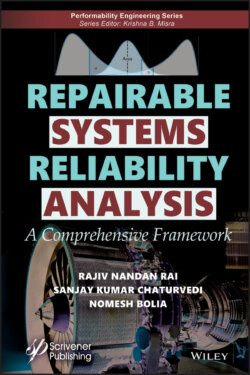Читать книгу Repairable Systems Reliability Analysis - Rajiv Nandan Rai - Страница 15
1.2 Perfect, Minimal, and Imperfect Repairs
ОглавлениеAs discussed earlier, a repairable system is a system that is restored to its functionable state after the loss of functionability by the actions other than replacement of the entire system. The quantum of repair depends upon various factors like criticality of the component failed, operational status of the system, risk index, etc. Accordingly, the management takes a decision on how much repair a system has to undergo. The two extremes of the repair are perfect and minimal repairs. A system is said to be perfectly repaired, if the system is restored to AGAN condition (as it is replaced with a new one). Normally, a perfect repair in terms of the replacement is carried out for very critical components, which may compromise operation ability, safety of the system, and/or personnel working with the system. On the other hand, a system is said to be minimally repaired, if its working state is restored to “as-bad-as-old” (ABAO). This type of repair is undertaken when there is heavy demand for the system to work for a finite time or the system will be undergoing preventive maintenance shortly or will be scrapped soon.
Any repair other than perfect and minimal repair comes under imperfect repair. Most of the repairs observed in day-to-day systems are imperfect repairs, i.e., a system is neither restored to AGAN conditions nor to ABAO conditions. The three types of repairs are pictorially represented in Figure 1.1.
Figure 1.1 Types of repair.
It can be seen from Figure 1.1 that in case of perfect repair, the system is rendered “AGAN” and the life starts at zero in the time scale signifying that the performance degradation is completely restored. In case of minimal repair, after the system is subjected to a repair action, its age remains same as before the repair action and there is no restoration of life below the previous age. So far the general repair is concerned, some of its life is renewed and the system starts functioning after being restored to somewhere between “ABAO” and “AGAN” state.
Figure 1.2 summarizes the techniques in vogue for reliability analysis for both repairable and non-repairable items, respectively.
Figure 1.2 Various techniques for reliability analysis.
A renewal process (RP) is a counting process where the inter-occurrence times are stochastically i.i.d. with an arbitrary life distribution. Under the RP, a single distribution can characterize the time between failures (TBF), and the frequency of repair appears constant. The non-renewal behavior occurs if this frequency of repairs increases (deteriorating systems) or decreases (system improving) influencing the corresponding maintenance costs. The homogeneous Poisson process (HPP) describes a sequence of statistically i.i.d. exponential random variables. Conversely, a non-homogeneous Poisson process (NHPP) [3, 4] describes a sequence of random variables that are neither statistically independent nor identically distributed. The NHPP is often used to model repairable systems that are subject to minimal repair. The generalized renewal process (GRP) allows the goodness of repairs within two extremities, viz., AGAN repair (RP) to the same-as-old repair (NHPP). The GRP is particularly useful in modeling the failure behavior of a specific unit and understanding the effects of repair actions on the age of that system. An example of a system to which the GRP is especially applicable is a system, which is repaired after a failure and whose repair neither brings the system to an AGAN or an ABAO condition, but instead partially rejuvenates the system. Therefore, one should be cautious on the fact that without looking at the actual behavior of the data may lead to underestimation or overestimation of engineering metrics.
The analysis by employing the parametric methods on scenarios of failure-repair requires a certain degree of statistical knowledge, the ability to solve complex equations and verification of distributional assumptions. Further, these equations cannot be solved analytically and require an iterative procedure or special software. Besides, parametric approaches are computationally intensive and not intuitive to a novice or an average person. The analysis of events, irrespective of the nature of the system-reparable or not reparable, should take an analysis path from non-parametric to versatile parametric model with graphical analysis being a common denominator. Undoubtedly, the choice of method depends on the data available and the questions we wish to answer.
